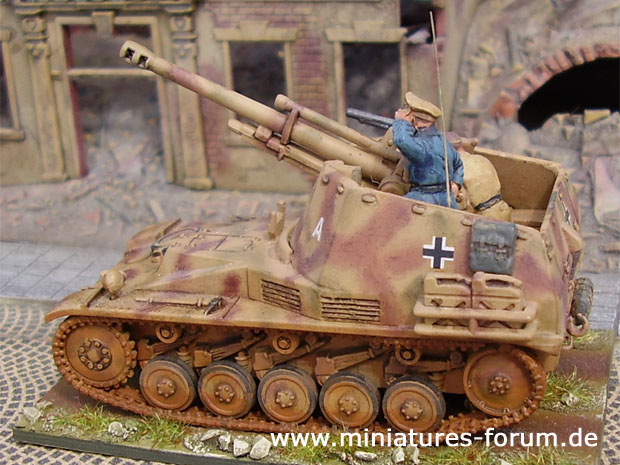German Panzer-Artillery II “Wespe” Self-Propelled Howitzer
Matchbox 1:76 Scale Vehicle Review

Wespe painted in a three-colour camouflage pattern introduced in 1943, with brown and olive green disruptive stripes over the dark yellow base colour. Many patterns existed, depending on local terrain conditions. The disruptive colours consisted of thick camouflage paste diluted with water, oil or fuel. The pattern could be washed off with gasoline if the vehicle had to be camouflaged differently. The colours were either sprayed or painted on. If paintbrushes were unavailable, the colours could be applied with a broom or rag. Some standard patterns were applied at the factory already, using templates, and they differed from the patterns applied by units in the field.
Contents
- Leichte Panzerhaubitze Wespe
- Officer and Crew Member
- Diorama Base
Evaluation
Excellent choice of subject, the 10.5 cm leichte Panzerhaubitze was a key fire support vehicle of Panzer and Panzergrenadier divisions. Wespe even served as a tank destroyer in emergency situations.
Scale model with good detail. The interior detailing is well done, except that the floor of the fighting compartment does not show the typical grating. The rear wall should be left off until the compartment has been painted, the parts can be difficult to reach otherwise. The exterior of the Wespe is not cluttered enough to suggest a vehicle on campaign, there is still plenty of room to add blanket rolls and other items of personal gear.
Intermediate level of difficulty: 58 parts. The running gear consists of 25 parts, hull and superstructure require 26 parts, the diorama base has five parts and two figures. The parts went together very well, and there was minimal flash.
The Wespe carries a radio, but there is no mounting bracket for the antenna. This part should be attached inside the compartment, just forward of the radio. The bracket needs to be angled to eliminate the slope of the armour plate, pointing the antenna straight up.
The kit includes decals of the 17. and 21. Panzer-Division, the latter serving in Africa. Unfortunately, there are no tactical markings of the armoured artillery branch of service.
Compatible with Airfix, Fujimi, Nitto, and VAC-U-CAST.
The tracks should not be fitted as early as section 2 of the manual suggests. Allow the running gear to dry overnight, otherwise the tight-fitting tracks will pull the drive sprockets out of alignment.
The rolled tarp attached to the right rear of the Wespe hull should actually be a muffler with an exhaust pipe leading into it.
The painting instructions for a Wespe of the 17. Panzer-Division are obviously in error, they are dated “Moscow 1941”, despite the fact that Wespe did not enter service until 1943. The camouflage pattern of earth brown over panzergrey may be correct for elements of the 17. PD at the time, but Wespe would have been painted in a 1943 camouflage pattern of Schokoladenbraun and/or Olivgrün disruptive stripes over the Dunkelgelb base colour. The same error places the vehicle with 21. Panzer-Division in “Tripoli 1942”. If Wespe fought in North Africa at all, it probably did not arrive until the 1943 Tunisian campaign.
The two miniatures included in this kit are dressed in Afrika Korps uniform, they are unsuitable for a vehicle deployed on the Eastern Front. The same is true of the palm tree which decorates the diorama base, although the base itself could be used to represent other theatres of operation.
The officer figure is not a Wespe crew member, the man looks like a battery commander who would not normally be serving a gun. One solution is to paint the figure as a Fallschirmjäger NCO wearing tropical uniform and the “Meier-Mütze”. Tropical uniform was worn in Europe during the summer months. Fallschirmjäger units served in the infantry role in the latter part of the war, and they were issued self-propelled guns.
The box cover and painting instructions show the Wespe correctly fitted with two subdued headlights, but the model has only one.
Wespe carries a Bosch „Panzerscheinwerfer“ headlight, but the missing Notek „Abstandsrückleuchte“ tail light will have to be scratchbuilt using a 2.5 × 1.25 × 0.6 mm section of polystyrene rod.
The fuel cannisters are too large, and they are not of the famous Jerrycan design. German 20 liter fuel cannisters were a standard item, they should be the same shape and design in every model kit. Millions of Jerrycans were produced, and there would have been no Blitzkrieg without them. Unfortunately, Matchbox offers a different type of “Jerrycan” in every model kit, sometimes two different cannisters in the same box even. Clearly, this additional design effort is a waste of time and creative energy, and it significantly reduces the authenticity of the kit. Not only did the Germans standardize their fuel cannisters, other nations copied the popular Jerrycan. Most allied vehicle crews were happy to use captured Jerrycans instead of their own flimsy fuel cannisters. Because Jerrycans were identical in shape and design, they were marked to differentiate benzine, diesel, engine oil, coolant and potable water cannisters.
The light machine gun mounted on the superstructure is not loaded, an unfortunate oversight. These weapons were either fitted with a small drum magazine or they had belted ammunition. If the weapon is mounted on the superstructure at all, it should be loaded and ready for action, otherwise the crew would probably have taken the LMG down and stowed it.
The Matchbox kit of the Wespe is unique in this scale, it’s a must-have for modellers, wargamers, and collectors. Open-topped armoured fighting vehicles are very interesting to model, they can be detailed inside, and there is enough room for crew members and a variety of personal gear not normally seen on other vehicles. The Wespe is relatively easy to build, and fun to paint.